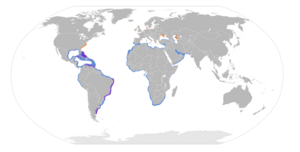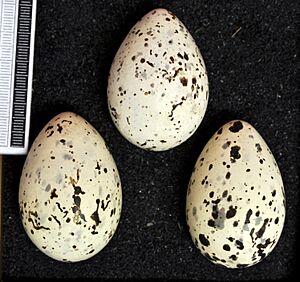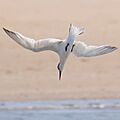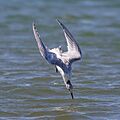Sandwich tern facts for kids
Quick facts for kids Sandwich tern |
|
|---|---|
 |
|
| Conservation status | |
| Scientific classification | |
| Genus: |
Thalasseus
|
| Species: |
sandvicensis
|
 |
|
| Synonyms | |
|
Sterna sandvicensis |
|
The Sandwich tern (Thalasseus sandvicensis) is a type of tern bird. It belongs to the family Laridae, which includes gulls. This bird is very similar to other terns like the lesser crested tern and Chinese crested tern. Sometimes, it even breeds with the lesser crested tern.
Sandwich terns live in many parts of the world. They breed in areas from Europe to the Caspian Sea. When winter comes, they fly south to places like South Africa, India, and Sri Lanka.
This tern is a medium-sized bird. It has grey feathers on its back and white feathers underneath. Its bill is black with a yellow tip. It also has a shaggy black crest on its head. In winter, this crest becomes smaller and its head turns white. Young Sandwich terns have grey and brown patterns on their backs and wings. They are also known for being quite noisy birds.
Sandwich terns build their nests on the ground. They usually lay one to three eggs. Like other terns in its group, the Sandwich tern eats fish. It catches fish by diving headfirst into the water. Males often offer fish to females as part of their courtship.
Contents
Meet the Sandwich Tern: A Seabird Story
Terns are seabirds that look a bit like gulls. However, they are usually lighter and have shorter legs. They have long, pointed wings that help them fly fast. Many terns also have a deeply forked tail. Most species are grey on top and white underneath. They often have a black cap on their head. This cap gets smaller or turns white in winter.
The Sandwich tern was first described in 1787. An expert named John Latham gave it the name Sterna sandvicensis. Later, scientists moved it to a new group called Thalasseus. This change happened after studying their mitochondrial DNA. These studies showed that different head patterns in terns meant they were different groups.
The name Thalasseus comes from the Greek word for "sea." The name sandvicensis comes from Sandwich, Kent, a place in England. This is where Latham first studied the bird. It's interesting because the name sandvicensis often refers to Hawaii. Hawaii used to be called the "Sandwich Islands." But the Sandwich tern does not live in Hawaii.
There are no different types (subspecies) of the Sandwich tern today. One bird that used to be a subspecies is now its own species. This is the Cabot's tern (T. acuflavidus). It lives along the Atlantic coasts of North and South America.
What Does a Sandwich Tern Look Like?
The Sandwich tern is a medium-large bird. It is about 37 to 43 centimeters (15 to 17 inches) long. Its wings can spread 85 to 97 centimeters (33 to 38 inches) wide. It weighs between 180 and 300 grams (6.3 to 10.6 ounces). In most places, it is easy to tell apart from other birds.
The Sandwich tern has a thin, sharp bill. It is black with a yellow tip. Its short legs are also black. The top of its wings are pale grey. Its belly is white. When it flies, it looks very pale. However, its main flight feathers get darker in summer.

Other terns like the lesser crested tern and elegant tern have all-orange bills. The lesser crested tern also has a grey rump. The elegant tern has a slightly longer, thinner bill. The Chinese crested tern looks most like the Sandwich tern. But it has a yellow bill with a black tip. Also, it lives in a different area, so you won't confuse them.
In winter, the adult Sandwich tern's forehead turns white. Young Sandwich terns have dark tips on their tails. Their backs and wings look scaly. This is similar to young roseate terns.
The Sandwich tern makes a very clear sound. Its call is a loud, grating kear-ik or kerr ink.
Life Cycle and Behavior
This bird breeds in very large groups called colonies. They live on coasts and islands. Sometimes, they nest inland on big freshwater lakes near the coast. They make their nests in a simple scrape on the ground. Each nest usually holds one to three eggs.
Unlike some smaller white terns, the Sandwich tern is not very aggressive. It does not fight much with animals that might try to eat its eggs or chicks. Instead, it relies on having many nests very close together. Nests are often only 20 to 30 centimeters (8 to 12 inches) apart. They also nest near other more aggressive birds. This helps protect them from predators.
Like all Thalasseus terns, the Sandwich tern catches fish by diving into the water. It almost always hunts in the sea. It usually dives straight down. It does not hover first like some other terns. Males often give fish to females. This is a special part of their courtship dance.
Conservation Status
The Sandwich tern lives in a very large area around the world. This area is estimated to be between 100,000 and 1,000,000 square kilometers (38,600 to 386,100 square miles). There are many Sandwich terns, with an estimated 460,000 to 500,000 birds.
Scientists do not believe the number of Sandwich terns is decreasing quickly. Because of this, the species is listed as "least concern" by the IUCN Red List. This means it is not currently at risk of disappearing.
The Sandwich tern is also part of an agreement called the Agreement on the Conservation of African-Eurasian Migratory Waterbirds (AEWA). Countries that are part of this agreement work together to protect these birds. They do things like protecting habitats and doing research. They also educate people about conservation.
-
T. sandvicensis with common terns
-
Sandwich terns on the dune, Heligoland
-
Sandwich terns resting in Sweden.












